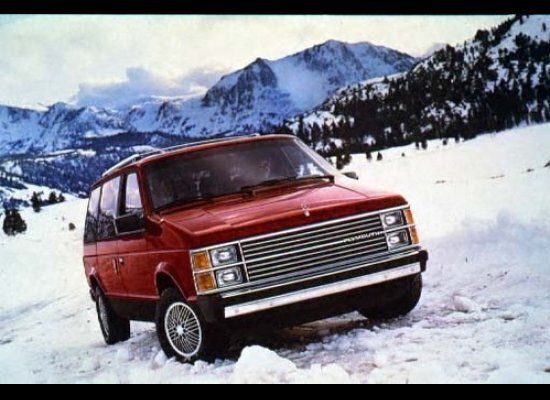
Kimberly Knox, a mom of three young kids in Indianapolis, wasn't ready to give up her crossover Toyota 4Runner two and a half years ago. But her mother-in-law was getting rid of her minivan and made her an offer she couldn't refuse.
Now Knox dreads getting into the 4Runner with all three kids. That's when the complaints of "he touched me; she touched me" begin. In the roomy minivan, there are "no touching issues," she said. Plus, it has a DVD player. The whole thing makes her life easier.
"Spread the word," she said. "Minis are cool."
Minivans could use the public relations. While sales of the boxy vehicles (sometimes called "mom-mobiles") have spiked 10.6 percent so far this year, according to AutoData, that's only because car sales in general are rising (by 10.3 percent year to date). Indeed buyers in pursuit of all types of vehicles are back in the market after nearly four years of sitting on sidelines. But minivans sit on dealer lots eight days more than other kinds of cars, the latest 2012 data from J.D. Power show.
Automakers are turning away from minis in favor of crossovers, which are more like SUVS but built with the underpinnings of a car -- something considered trendier these days. Chrysler, which invented minis in the 1980s, is planning to eliminate one of its two models. Starting in 2014, Chrysler will sell only the Chrysler Town and Country and eliminate the Dodge Grand Caravan, the automaker has said. General Motors and Ford dropped their models in the late 2000s because they just weren't selling well.
Fuel economy is not really an issue, since minivans generally rack up better gas mileage than many SUVs and crossovers. And even those cars are still selling well, despite higher gas prices.
This year, just seven minivans are for sale in the United States, according to Autodata. More than 40 crossovers are available.
Minivans used to be much more popular. In 2000, a record 1.3 million vehicles were sold in America; in 2005, just shy of 1 million were bought. By 2011, only 540,000 were sold.
This year's data from J.D. Power also show 33 percent of minivan buyers are women. That figure does not take into account that many people buy minivans as a family purchase and a husband's name might be listed on the registration but his wife could be the primary one driving the car.
"Sales are up for minivans, but so are sales for everything else," said Jessica Caldwell, senior analyst for car buying site Edmunds.com. "Minivans have their core buyers," added Caldwell, referring to mothers of young kids who need jumbo-size vehicles to cart them around in. "They don't get many looks from anyone else."
Brett Berk, author of "The Gay Uncle's Guide to Parenting" and a car columnist at Vanity Fair, said there's a clear reason why people love to hate minivans: misogyny.
"It's a patriarchy, thus we hate the cars women are supposed to drive the way we denigrate some cars and call them chick cars," he said.
And that could be why some men are so loath to end up in one. In an alternate universe, minivans could be the ultimate sign of virility and manliness: How better to show you've caught a woman than to drive her around along with your mutual progeny in a big vehicle? But instead, many men act as if buying a minivan is akin to being emasculated.
"There's no other explanation," Berk said. "There's also the fact that I've never been in a minivan that didn't smell like dried sour milk."
In 2010 Toyota tried to make minivans cool again with a cute set of commercials, in which a dorky dad and an attractive but slightly obsessed mom rapped about their "swagger wagon." Lots of people shared the commercial on Facebook and the term swagger wagon became a lovingly mocking term for many parents' boxy rides.
It helped sales, too. Sienna sales rose 13 percent in 2011.
When automakers try to make minivans appear more trendy, sales go up. After Honda redesigned its Odyssey minivan in 2011, critics loved what they called a "lightning bolt" design on the side. If it weren't for the fact that supplies were constrained after last year's tsunami in Japan, the Odyssey would have been the No. 1 selling minivan in the United States.
But there is some hope for minivan makers: In January Chrysler showed off a concept minivan, the 700C, at the Detroit auto show. With side windows shaped like cat's-eyes, the minivan sports a look that many consider cool, which is something people usually never say about a minivan.
Making the transition to a minivan isn't always easy for many moms. Julie Guy, a mother of three kids in Sammamish, Wash., previously looked at other women driving minivans and assumed they were entrenched in the mom lifestyle and had given up projecting their own image in exchange for convenience.
But once she had two kids, Guy fell in love with the idea of a minivan's automatic sliding door that opens with the click of a button. Her life had become more challenging, in part because she had to cart around so much, Guy said. Moms (and other parents) can tote around lot of stuff (something Berk calls "lifeboating"), carrying anything one could possibly need in a day, like diaper bags, snacks, juice boxes, brushes, sunscreen, hats, extra clothes, stuffed animals or strollers. The minivan made sense for Guy, even though she felt like she was driving around something the size of her first apartment.
"They don't see the usefulness as being a bigger value than image," Guy said. "For me it was like, forget it. I need a big car with sliding doors. Forget my image. Someday I'll drive something cool again."
CORRECTION: A previous version of this article stated that the Dodge Grand Caravan is to be phased out next year; plans are to phase out the model by 2014.

